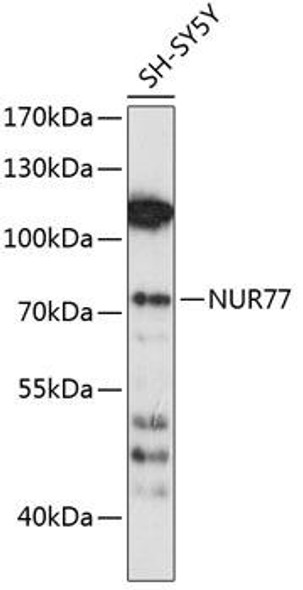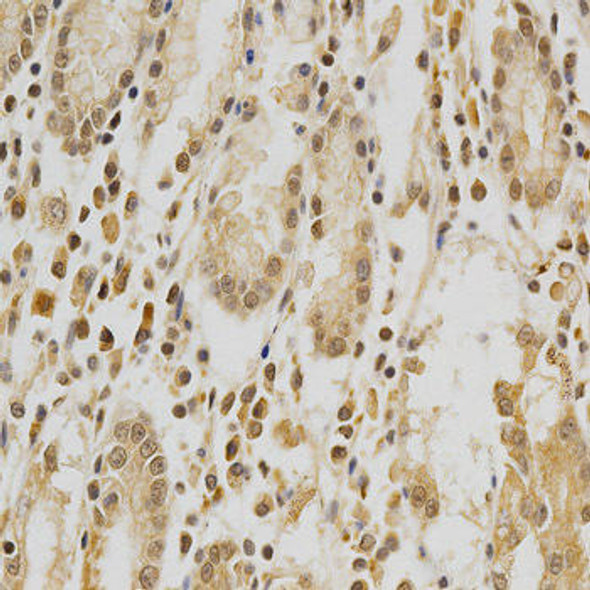Description
Anti-FOXM1 Antibody (CAB2493)
The FOXM1 Polyclonal Antibody (CAB2493) is specifically designed for research involving FOXM1, a transcription factor that plays a key role in cell cycle progression and cancer development. This antibody, produced in rabbits, exhibits high reactivity with human samples and has been validated for use in Western blot applications. It effectively binds to the FOXM1 protein, enabling accurate detection and analysis in a variety of cell types, making it an excellent tool for studies in cancer biology and cell proliferation.FOXM1 is a critical regulator of cell division and is often overexpressed in various types of cancer, promoting tumor growth and progression.
Its involvement in cell cycle control and tumor development make it a valuable target for research aimed at understanding cancer biology and identifying potential therapeutic targets. The FOXM1 Polyclonal Antibody is essential for studying the functions of FOXM1 and its implications in cancer pathology, providing valuable insights into potential treatment strategies for cancer patients.
| Antibody Name: | Anti-FOXM1 Antibody |
| Antibody SKU: | CAB2493 |
| Antibody Size: | 20uL, 50uL, 100uL |
| Application: | WB |
| Reactivity: | Human, Mouse, Rat |
| Host Species: | Rabbit |
| Immunogen: | Recombinant fusion protein containing a sequence corresponding to amino acids 1-350 of human FOXM1 (NP_973732.1). |
| Application: | WB |
| Recommended Dilution: | WB 1:500 - 1:2000 |
| Reactivity: | Human, Mouse, Rat |
| Positive Samples: | SW620, SKOV3, A-549, A-431, HeLa, Mouse heart, Mouse spleen, Mouse thymus, Rat thymus |
| Immunogen: | Recombinant fusion protein containing a sequence corresponding to amino acids 1-350 of human FOXM1 (NP_973732.1). |
| Purification Method: | Affinity purification |
| Storage Buffer: | Store at -20'C. Avoid freeze / thaw cycles. Buffer: PBS with 0.02% sodium azide, 50% glycerol, pH7.3. |
| Isotype: | IgG |
| Sequence: | MKTS PRRP LILK RRRL PLPV QNAP SETS EEEP KRSP AQQE SNQA EASK EVAE SNSC KFPA GIKI INHP TMPN TQVV AIPN NANI HSII TALT AKGK ESGS SGPN KFIL ISCG GAPT QPPG LRPQ TQTS YDAK RTEV TLET LGPK PAAR DVNL PRPP GALC EQKR ETCA DGEA AGCT INNS LSNI QWLR KMSS DGLG SRSI KQEM EEKE NCHL EQRQ VKVE EPSR PSAS WQNS VSER PPYS YMAM IQFA INST ERKR MTLK DIYT WIED HFPY FKHI AKPG WKNS IRHN LSLH DMFV RETS ANGK VSFW TIHP SANR YLTL DQVF KQQK RPNP ELRR NMTI KTEL PLGA RR |
| Gene ID: | 2305 |
| Uniprot: | Q08050 |
| Cellular Location: | Nucleus |
| Calculated MW: | 82kDa/84kDa/88kDa |
| Observed MW: | 108kDa |
| Synonyms: | FKHL16, FOXM1B, HFH-11, HFH11, HNF-3, INS-1, MPHOSPH2, MPP-2, MPP2, PIG29, TRIDENT, FOXM1 |
| Background: | The protein encoded by this gene is a transcriptional activator involved in cell proliferation. The encoded protein is phosphorylated in M phase and regulates the expression of several cell cycle genes, such as cyclin B1 and cyclin D1. Several transcript variants encoding different isoforms have been found for this gene. |
| UniProt Protein Function: | FOXM1: a transcriptional activator factor. Contains 1 fork-head domain. May play a role in the control of cell proliferation. Appears to be expressed only in adult organs containing proliferating/cycling cells or in response to growth factors. Also expressed in epithelial cell lines derived from tumors. Not expressed in resting cells. Phosphorylated in M (mitotic) phase. Three splice variant isoforms have been described. Isoform 1 and isoform 2 appear to be the only activators of gene transcription. Isoform 3, found in rat, does not seem to exist in human. |
| UniProt Protein Details: | Protein type:DNA-binding; Transcription factor Chromosomal Location of Human Ortholog: 12p13 Cellular Component: nucleoplasm; cytoplasm Molecular Function:protein binding; DNA binding; sequence-specific DNA binding; transcription factor activity; protein kinase binding Biological Process: transcription from RNA polymerase II promoter; regulation of Ras protein signal transduction; regulation of cell cycle; positive regulation of transcription, DNA-dependent; negative regulation of transcription from RNA polymerase II promoter; DNA repair; negative regulation of stress-activated MAPK cascade; liver development; cell cycle; regulation of cell proliferation; DNA damage response, signal transduction by p53 class mediator resulting in transcription of p21 class mediator; regulation of transcription, DNA-dependent; positive regulation of cell proliferation; positive regulation of transcription from RNA polymerase II promoter; mitotic cell cycle; regulation of cell growth; negative regulation of transcription, DNA-dependent; G2/M transition of mitotic cell cycle; vasculogenesis |
| NCBI Summary: | The protein encoded by this gene is a transcriptional activator involved in cell proliferation. The encoded protein is phosphorylated in M phase and regulates the expression of several cell cycle genes, such as cyclin B1 and cyclin D1. Several transcript variants encoding different isoforms have been found for this gene. [provided by RefSeq, Jul 2011] |
| UniProt Code: | Q08050 |
| NCBI GenInfo Identifier: | 12644391 |
| NCBI Gene ID: | 2305 |
| NCBI Accession: | Q08050.3 |
| UniProt Related Accession: | Q08050 |
| Molecular Weight: | |
| NCBI Full Name: | Forkhead box protein M1 |
| NCBI Synonym Full Names: | forkhead box M1 |
| NCBI Official Symbol: | FOXM1 |
| NCBI Official Synonym Symbols: | MPP2; HFH11; HNF-3; INS-1; MPP-2; PIG29; FKHL16; FOXM1A; FOXM1B; FOXM1C; HFH-11; TRIDENT; MPHOSPH2 |
| NCBI Protein Information: | forkhead box protein M1 |
| UniProt Protein Name: | Forkhead box protein M1 |
| UniProt Synonym Protein Names: | Forkhead-related protein FKHL16; Hepatocyte nuclear factor 3 forkhead homolog 11; HFH-11; HNF-3/fork-head homolog 11; M-phase phosphoprotein 2; MPM-2 reactive phosphoprotein 2; Transcription factor Trident; Winged-helix factor from INS-1 cells |
| Protein Family: | Forkhead box protein |
| UniProt Gene Name: | FOXM1 |
| UniProt Entry Name: | FOXM1_HUMAN |
 | Western blot analysis of extracts of various cell lines, using FOXM1 antibody at 1:1000 dilution. Secondary antibody: HRP Goat Anti-Rabbit IgG (H+L) at 1:10000 dilution. Lysates/proteins: 25ug per lane. Blocking buffer: 3% nonfat dry milk in TBST. Detection: ECL Basic Kit. Exposure time: 90s. |
 | Chromatin immunoprecipitation analysis of extracts of 293T cells, using FOXM1 antibody and rabbit IgG. The amount of immunoprecipitated DNA was checked by quantitative PCR. Histogram was constructed by the ratios of the immunoprecipitated DNA to the input. |









